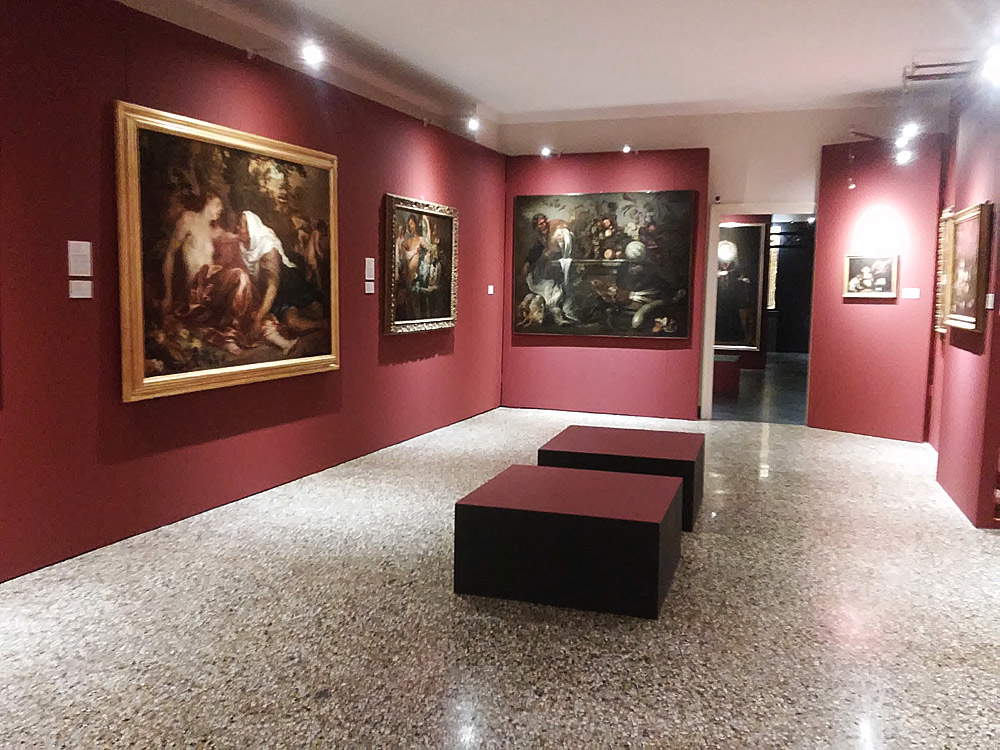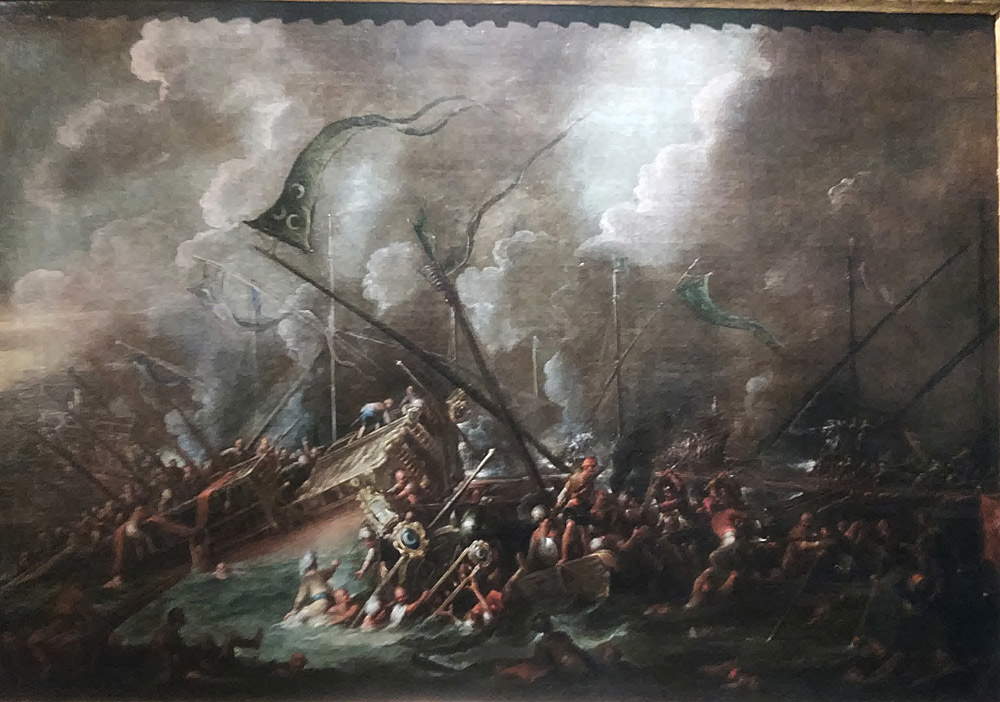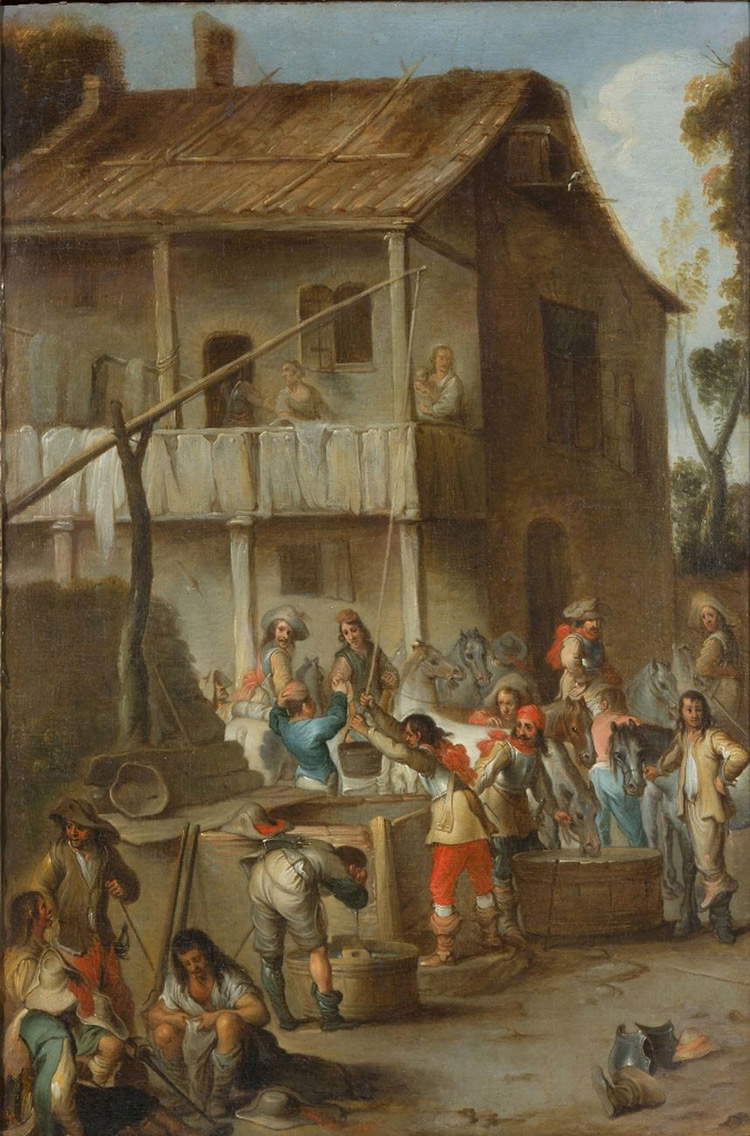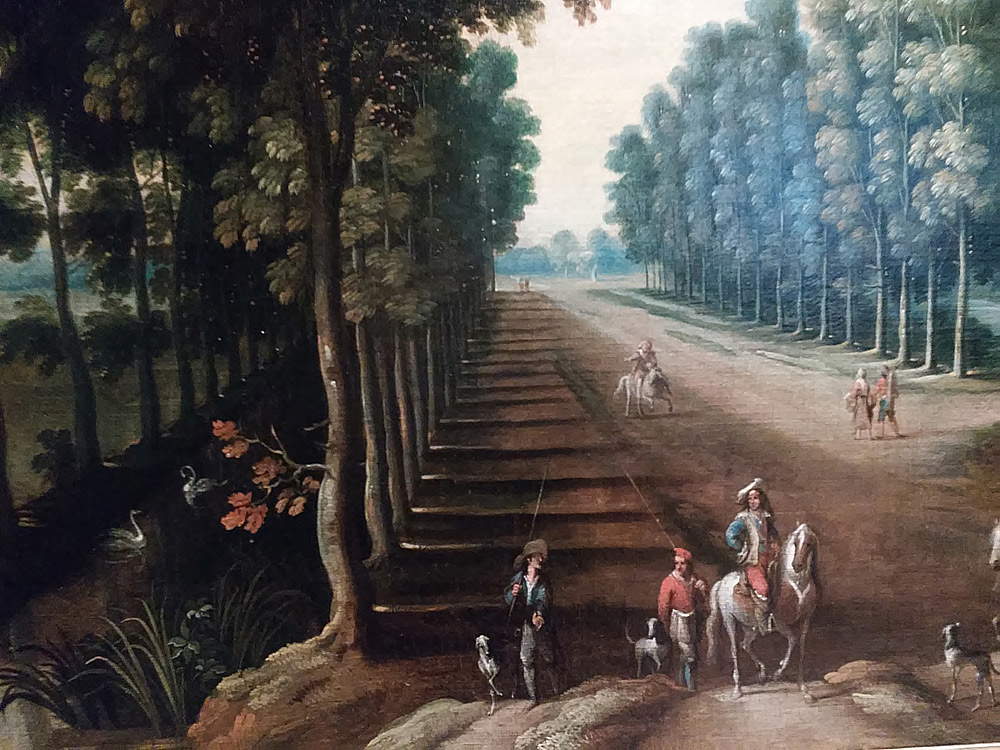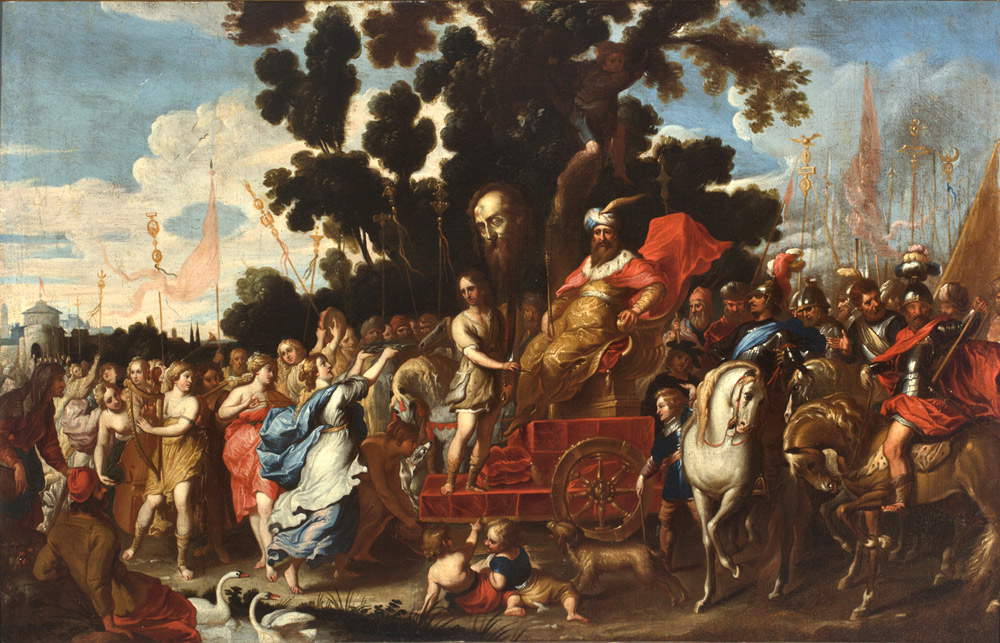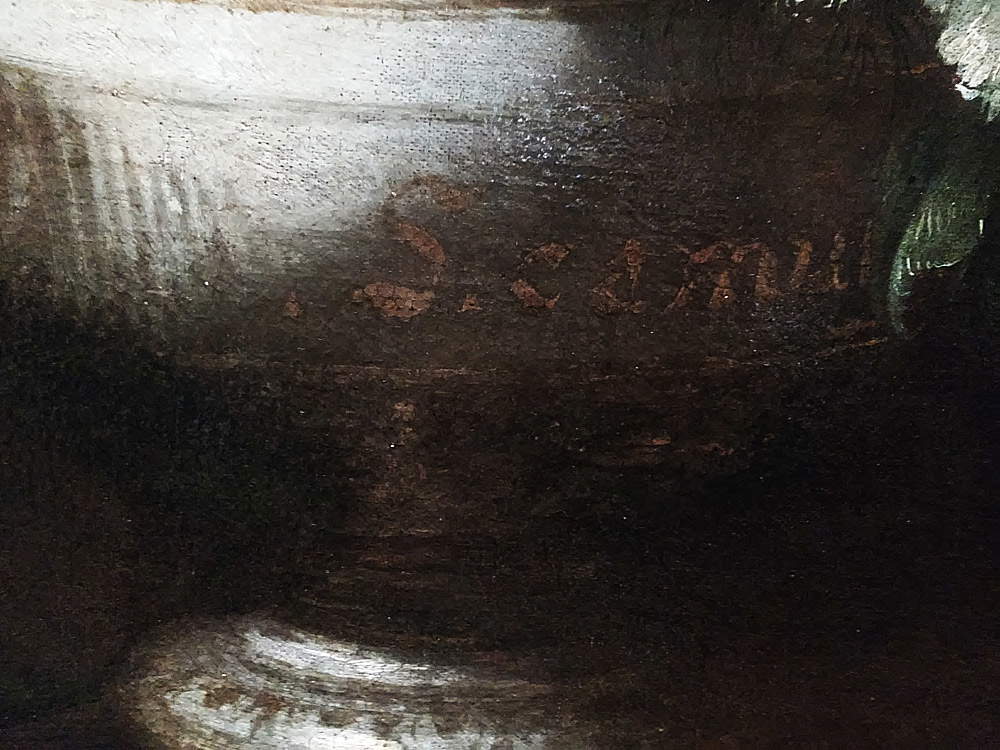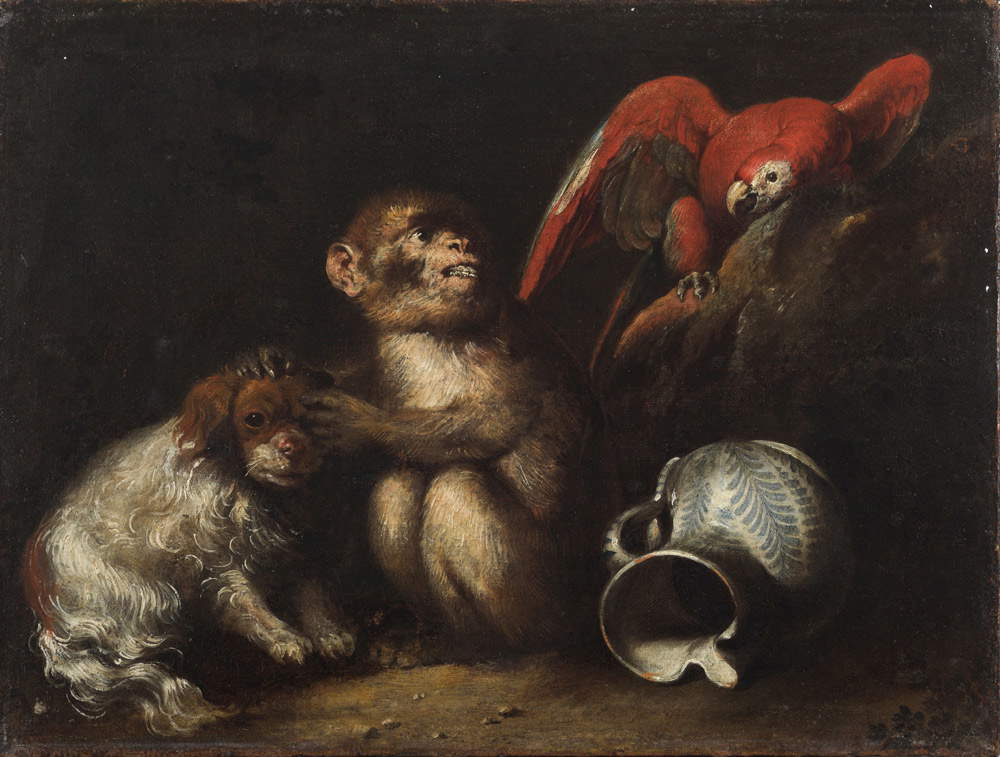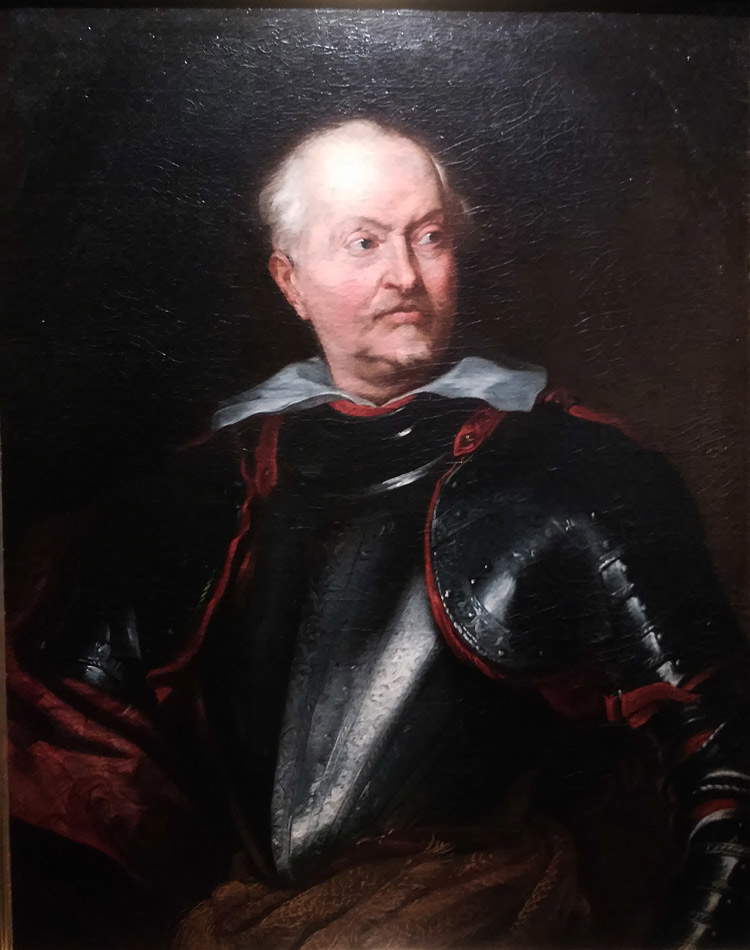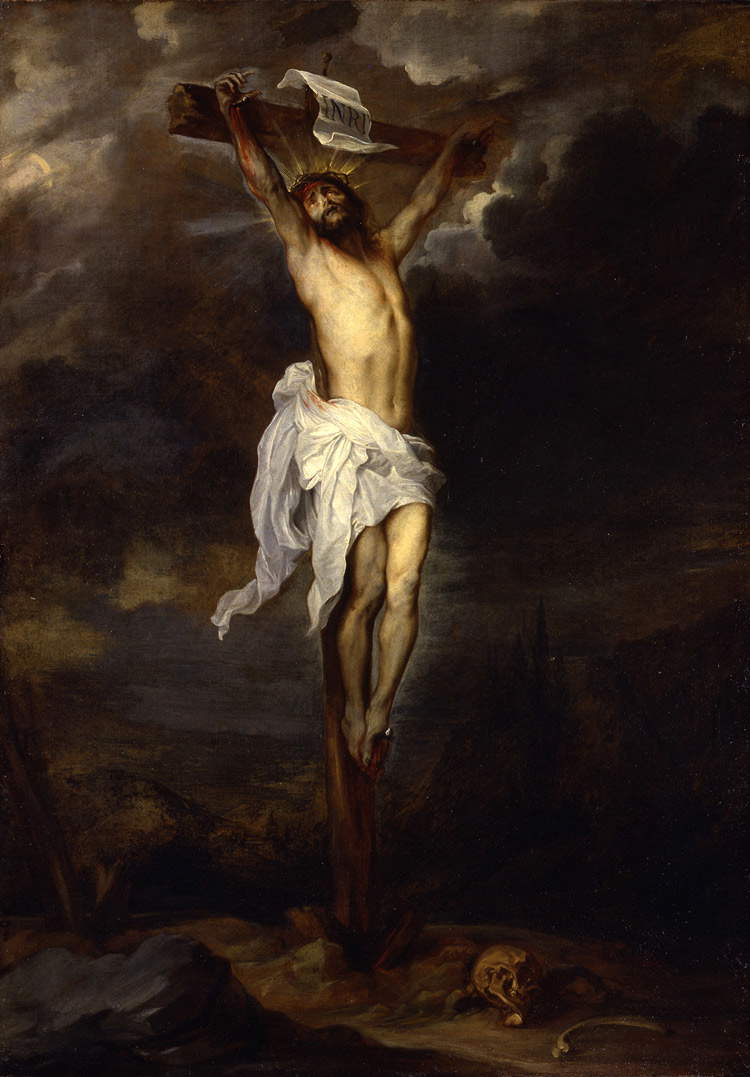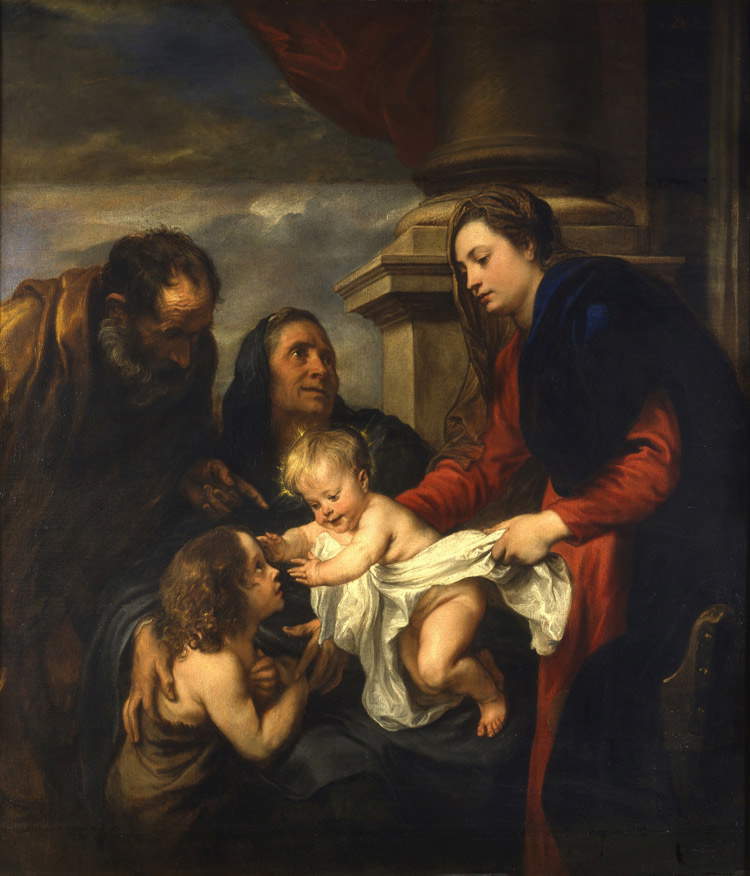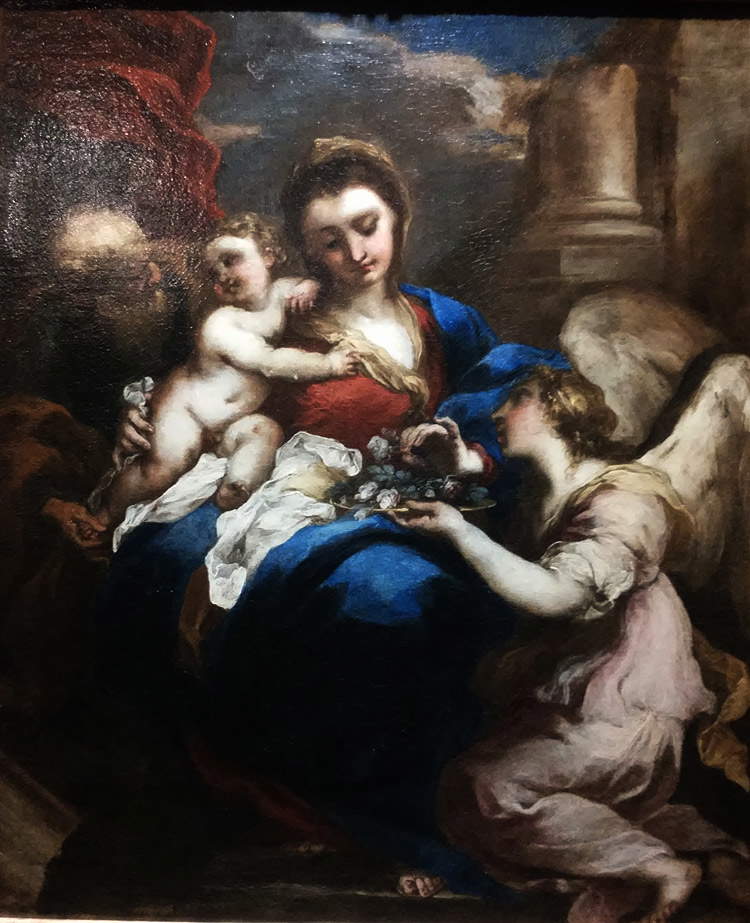by Federico Giannini (Instagram: @federicogiannini1), published on 25/04/2018
Categories: Exhibition reviews
/ Disclaimer
Review of the exhibition 'Van Dyck and His Friends' in Genoa, Palazzo della Meridiana, February 9 to June 10, 2018.
Despite the fact that the public has witnessed in recent years an increase in the number of exhibitions in which the topic of artistic connections between Genoa and Flanders in the seventeenth century was touched upon, the topic of the Flemish in Liguria has a relatively recent critical history: apart from the first pioneering studies that followed one another, albeit with rather sporadic frequency, for most of the twentieth century, and in some cases even earlier, it dates back to 1997 the first contribution that intended to systematically address the study of the relations between Liguria and Flanders over four centuries, from the fourteenth to the seventeenth century (this was the volume Pittura fiamminga in Liguria, edited by Piero Boccardo and Clario Di Fabio), and the first research by Anna Orlando, a scholar who has devoted much of her career to the in-depth study of these issues and who this year is curator of the exhibition Van Dyck e i suoi amici. Flemings in Genoa 1600-1640, which is being held in the rooms of Palazzo della Meridiana in the Ligurian capital. This is a new, important chapter in an exhibition history that has offered many opportunities to illuminate such relationships: in the last year alone, one could mention the exhibition on van Dyck between Genoa and Palermo, or the monographic exhibition on Sinibaldo Scorza, while going even further back in time, it is impossible not to refer to an exhibition such as L’età di Rubens, held at Palazzo Ducale in 2004.
The exhibition at Palazzo della Meridiana is an important chapter for several reasons. A true and thorough research exhibition, which comes after a good twenty years of study by the curator, Van Dyck and His Friends presents a truly remarkable amount of unpublished works, digs into inventories (publishing documents that have also never been seen before) to take the most accurate picture of the presence of the Flemish painters in Genoa between 1600 and 1640, and offers insights to better frame still open questions (just a couple of examples: the terms of the collaboration between Jan Roos and Anton van Dyck, and the role of Cornelis de Wael in the art market of Genoa at the time and in the context of the relationships between Flemish artists arriving in the city), and offers some decidedly interesting discoveries and novelties: among them, a Nymph and Satyr that Anna Orlando believes to be the result of the joint work of Roos and van Dyck and which she uses to corroborate some theses about the links between the two artists that will be discussed in more detail later, and a Still Life by Stefano Camogli that is currently the only signed work by the artist, and therefore a fundamental starting point for a more robust reconstruction of his activity (indeed, it is a painting already mentioned in two essays, one by Anna Orlando and the other by Daniele Sanguineti, both published in 2017, but it is exhibited here for the first time). And like any research exhibition, the one at Palazzo della Meridiana represents a stage, rather than a goal: there is still much work to be done, also in light of the fact that, as Roberto Santamaria points out in his essay in the catalog, “compared to the hundreds of Flemish paintings listed in the inventories, few have come down to the present day and, among these, only a few can be traced back to the documents with absolute certainty.”
Who then were van Dyck’s “friends”? With about fifty paintings, eight of them by the hand of the great Antwerp-born painter, the exhibition uses the Genoese sojourn of Anton van Dyck (Antwerp, 1599 - London, 1640) as a pretext, who arrived in the city when he was just 22 in 1621 and left for Flanders in 1627 after spending at least four years of his six years in Italy in Liguria (in fact, the artist made his base in Genoa to make frequent trips to the rest of the peninsula), to reconstruct the events of the colony of Flemish artists active in Genoa in the first forty years of the seventeenth century: what were the relationships between artists and patrons, what genres were most popular, what kinds of collaboration were established among Flemish artists, what were the relationships between the workshops, how the collectors of the time took an interest in their works. It is worth remembering that, in the period examined by the exhibition, trade and political relations between Genoa and Flanders were very strong: the territory roughly corresponding to present-day Belgium at the time constituted the state of the Spanish Netherlands and was under direct dependence of the Habsburg Empire. Spain, the greatest world power in the early seventeenth century, needed to control Flanders by avoiding transit through France or by sea: the safest route was therefore through Genoa, up through the Duchy of Milan, and through Franche-Comté and Luxembourg. Genoa thus became not only a fundamental logistical crossroads but also a place of financial transactions, with the result that in a very short time during the 16th century the city became one of the richest in the world. In order to facilitate banking and commercial transactions, a large Genoese colony settled in the main cities of Flanders, above all Antwerp: paintings, which were considered safe havens (Roberto Santamaria recalls how Genoa had managed to become so powerful partly because it was able to diversify and constantly reinvest its fortunes), became important commodities of exchange, with the consequence that several Flemish artists wished to travel directly to Genoa both to better meet the ever-growing demands of Ligurian patrons and to update themselves with continuous training trips to Italy. And many eventually ended up setting up their ateliers on the shores of the Ligurian Sea.
 |
| A room in the exhibition Van Dyck and His Friends. |
The exhibition, after showing part of van Dyck’sIconography, that is, the gallery of printed portraits of his contemporaries that the artist took to compose after his return to Antwerp in 1627, opens by introducing the public to one of these ateliers, that of Cornelis de Wael (Antwerp, 1592 - Rome, 1667). An artist of relevant stature, remembered in Raffaele Soprani’s Lives especially for his battle scenes, some of which are featured in the exhibition, de Wael was also a knowledgeable manager and broker, so much so that he soon became one of the points of reference for the Flemish community in Genoa. Above all, however, he was a painter who demonstrated considerable ability to meet the needs of the market by continually updating his figurative repertoire and himself playing a major role in the spread of certain genres. The exhibition offers the public a precise and detailed analysis of these qualities of Cornelis de Wael: a Night Battle at Sea between Turks and Christians, unpublished (except for the contribution, in print at the time of the writing of the catalog, by Alison Stoesser: it is the first monograph on the brothers Cornelis and Lucas de Wael), is a work that combines two of the typologies favored by patrons of the time (the navy and the battle scene, two genres to whose definition de Wael’s role greatly aided), while Soldiers at a Tavern demonstrates the entry, in the skills mastered by the artist, of genre painting, deepened by a stay in Rome and the study of the coeval works of the bamboccianti, who specialized in such popular slice of everyday life of the time.
Space is also given to the figures of Lucas de Wael (Antwerp, 1591 - 1661), whose contours have been redefined more precisely by Anna Orlando (often considered a minor artist, overshadowed by the shadow of his brother Cornelis, Lucas was in fact a fine landscape painter, as evidenced by the Landscape with Hunters at a Standstill, a work that, as was often the case in their workshop, was made in collaboration with Cornelis, who was responsible for the insertion of the figures) and by Jan Wildens (Antwerp, 1585/1586 - Rome, 1653), another landscape painter, disinterested in “the minute observation of the datum of nature defined in detail” and specialized in “more airy landscapes, of great decorative value, often connoted by an episode of everyday life” (so Anna Orlando in the catalog). Highly represented in Genoese museums, he is shown in the exhibition with a couple of his landscapes executed in collaboration with Cornelis de Wael: an unprecedented Tree-lined Avenue with figures that picks up on a motif (that of the tree-lined avenue) typical of Wildens’ production, and a Spring in an Italian Garden, which combines fantasy elements with details taken from reality, intended to evoke the sweetness of a Genoese April in the eyes of the relative. Closely related to the works of Cornelis de Wael are then those of Vincent Malò (Cambrai, c. 1602/1606 - Rome, 1644) who, having arrived in Genoa in the 1930s (as opposed to de Wael, who instead was perhaps already present in the 1910s), and while remaining independent of the older master, drew on his earlier compositions in painting the Trials of Moses, another unpublished canvas.
 |
| Cornelis de Wael and Andries van Eertvelt (?), Night Battle at Sea between Turks and Christians (oil on canvas, 95 x 136 cm; Private collection) |
 |
| Cornelis de Wael, Soldiers at a Tavern (oil on canvas, 90 x 58.5 cm; Private collection) |
 |
| Lucas de Wael and Cornelis de Wael, Landscape with Hunters at a Standstill (oil on canvas, 98 x 140 cm; Private Collection) |
 |
| Jan Wildens and Cornelis de Wael, Tree-lined Avenue with Figures (c. 1613-1614; oil on canvas, 92 x 134 cm; Giuliana and Eugenio Tuillier Collection) |
 |
| Jan Wildens and Cornelis de Wael, Spring in an Italian Garden or April (c. 1613-1614; oil on canvas, 123 x 191 cm; Private Collection) |
 |
| Vincent Malo, Triumph of David (oil on canvas, 69 x 109 cm; Private collection) |
In the next room, the exhibition continues to explore the dynamics of workshops in Genoa in the early decades of the seventeenth century (and, consequently, the environment that welcomed Anton van Dyck upon his arrival in the city in 1621). In particular, the focus is on how some of the Flemish artists who came to Liguria had become real landmarks, also able to train younger artists, including many locals. One of the first “creations” of the Flemings was the aforementioned Stefano Camogli (Genoa, c. 1610 - 1690), also known as “il Camoglino,” because of where his family came from. As mentioned above, the exhibition features what, at the present state of knowledge, is his only signed work, a Still Life with Vase of Flowers and Copper Basin with Fruit. Camogli was among the most appreciated naturamortisti of Genoa at the time, and that of still life was, in turn, a genre that had a vast fortune, so much so that it was declined in a number of variants: above all, that of the animated still life that, in addition to the presence of flowers, fruit and disparate objects, sees the appearance of animals. Excelling in this genre were Pieter Boel (Antwerp, 1622 - Paris, 1674), present with a couple of canvases including a striking Still Life with Parrot and Flowers as Vanitas, which strikes the viewer for the veracity of the bird, and Anton Maria Vassallo (Genoa, 1617/1618 - Milan, 1660), present with a very tasty unpublished depicting anAllegory with a small dog, monkey, parrot and jug, respectively symbols of fidelity, lust, vanity and instability: probable evidence that was meant to serve Vassallo to have a repertoire of figures for further compositions, was nevertheless read by Anna Orlando as an allegory of love that, if it succumbs to lust and vanity, can threaten fidelity.
If Boel was a direct pupil of Cornelis de Wael, and Vassallo was instead a pupil of Vincent Malò, Camogli, on the other hand, studied with Jan Roos (Antwerp, 1591 - Genoa, 1638), also known as “Giovanni Rosa,” an artist of high stature who arrived in Genoa in 1614. Described by Anna Orlando as “the most significant personality among the Flemings in Genoa from the point of view of strictly pictorial scope and his relations with van Dyck” (so much so that he is the only artist to whom a special essay is devoted in the catalog), he became noted in the city for the skill with which he was able to tackle different genres (from still life to sacred themes, from animal scenes to mythological episodes), for the wisdom with which he could layout his compositions, for his high degree of refinement, for his ability to handle narrative inserts in certain of his paintings. In Still Life of Fruits, Vegetables and Flowers, a high example of the genre in which perhaps Jan Roos best distinguished himself, the painter renders “a veritable ’triumph’ of flowers and fruits-black, amber and green grapes, oranges, chestnuts, figs, pomegranates , opium poppy ovaries, watermelon, pumpkins, almonds, and melons-portrayed within a setting connoted courtly by the presence of a column base and a red drape in the background” (so Raffaella Besta in the catalog). Of considerable interest is the aforementioned painting with Nymph and Satyr, unpublished, according to the curator the result of the collaboration between Roos and van Dyck, and therefore particularly significant for trying to explore the relationship between the two artists. Specifically, Roos would have been in charge of the incredible still life piece (the verisimilitude and meticulous basket of grapes) and the nymph, of a female type quite similar to others found in his paintings, while van Dyck would have been in charge of painting the satyr. What, then, are the terms of the bond that united the two painters, even in view of the fact that we know of other works they did by four hands? Anna Orlando’s hypothesis has the young van Dyck at first as a guest in the atelier of his more experienced colleague, who had been in town for seven years before his arrival. The roles would then be reversed, with Jan Roos who, as the skilled, well-connected and experienced painter that he was, would be called upon by van Dyck to support him in the making of his paintings at times when the younger artist was overworked. This was also because of the fact that Roos’ help could also extend beyond still life pieces, given the artist’s mastery with a wide variety of genres.
 |
| Stefano Camogli, Still Life with Vase of Flowers and Copper Basin with Fruit (after 1638; oil on canvas, 94 x 120 cm; Private Collection), detail of the artist’s signature |
 |
| Pieter Boel, Still Life with Parrot and Flowers as Vanitas (c. 1650-1668; oil on canvas, 90 x 123 cm; Pietra Ligure, Private Collection) |
 |
| Anton Maria Vassallo, Allegory with Small Dog, Monkey, Parrot and Pitcher (oil on canvas, 37.5 x 49 cm; Private Collection) |
 |
| Jan Roos, Still Life of Fruit, Vegetables and Flowers (oil on canvas, 100 x 138 cm; Genoa, Strada Nuova Museums, Palazzo Bianco) |
 |
| Anton van Dyck and Jan Roos, Nymph and Satyr with Basket of Grapes or Allegory of Lust (c. 1622-1623; oil on canvas, 102 x 126 cm; Private Collection), detail |
Centered around the personality of Anton van Dyck is the entire second part of the exhibition, which starts in the third room, where the genre of portraiture is addressed. We immediately find a couple of well-known works by Anton van Dyck, admirable examples of his production for Genoese high society: the portrait of the young Ansaldo Pallavicino in the Galleria Nazionale di Palazzo Spinola, “one of the most effective portraits of a child of the many made by the painter” (Farida Simonetti), and The Jeweler Giacomo Pucci with his son Alberto, one of the last works executed by the painter in Genoa, which also gives us a way to reflect on the role of the portrait as a status symbol, since Giacomo Pucci was not a nobleman, but he was nonetheless a wealthy merchant and cared to give of himself an image befitting the social status he had achieved through his work and intended to pass on to his son (the presence of the child should probably be read in this sense). Alongside these works, a little-known portrait finds its place in the exhibition, that of Ambrogio Spinola, captain general of the army of Flanders for the Habsburg empire, one of the most powerful men of his time and, by virtue of this, portrayed by some of the greatest artists of the time (Rubens and Velázquez above all). Made known by Maria Grazia Bernardini in 2014, the portrait demonstrates a sublime quality, which brings it in common with other portraits of the same subject painted by van Dyck, and therefore leaves us to rule out the idea that it is a copy: on the contrary, it is an excellent work, probably executed “from memory,” that is, without the painter having the posed subject in front of him, but using repertories (a hypothesis, the latter, formulated for reasons of chronological compatibility on the movements of van Dyck and Ambrogio Spinola). Closely related to van Dyck’s masterpieces is an unpublished portrait by Jan Roos, a portrait of Agostino Spinola, attributed to the artist on a stylistic basis and executed around 1617, shortly before the death of the sitter: this is an important discovery because there is an identical posthumous portrait of the same subject by van Dyck, currently preserved in Cincinnati, and Roos’ work has thus made it possible to identify the direct precedent of the van Dyckian portrait, thus guaranteeing the resolution of a problem in the field of studies on the painter.
The fourth and final room, dedicated to the sacred, but also to the suggestions that van Dyck exerted on the Genoese painters of the seventeenth century, is less “revolutionary” since it does not present any striking discoveries, but it is capable of exerting a strong fascination because it presents a couple of wonderful, suggestive comparisons. The first revolves around one of van Dyck’s most famous works, the Spirant Christ of the Royal Palace, an extraordinary canvas famous for the choice of displaying the cross in foreshortened view, on the left, silhouetted against a gloomy landscape over which a storm is about to break. It is a painting imbued with Baroque enchantment, which “emphasizes the desolate loneliness and drama of Christ’s sacrifice” and where “the sorrowful emotionality of Christ is emphasized by the stark, rocky landscape that surrounds the cross, losing itself in the darkness of the background” (Luca Leoncini). The Crucifixion by Giovanni Benedetto Castiglione known as Il Grechetto (Genoa, 1609 - 1664) revisits the Vandyckian precedent with its powerful charge of pathos (which is different, however: no longer solitary drama, but participatory drama) and with its frayed brushstrokes that to some extent anticipate and foreshadow Alessandro Magnasco. Similarly, Valerio Castello ’s Sacred Family with an Angel (Genoa, 1624 - 1659), with its play of glances and gestures, hints at a way of treating the affections that is amply reflected in van Dyck’s two Sacred Families exhibited at Palazzo della Meridiana: The one from the Banca Carige collections, for which the exhibition formulates the hypothesis of a commission from the powerful Di Negro family, and where the Flemish artist does his utmost in a remarkably tender piece, that of the Infant Jesus reaching out to touch the face of St. Joseph with his little hand; and the one from the Galleria Sabauda in Turin, also a work of poignant lyricism, especially in the piece of the Child who smilingly approaches a more perplexed St. John.
 |
| Anton van Dyck, Portrait of Ansaldo Pallavicino (c. 1625; oil on canvas, 108 x 64 cm; Genoa, Galleria Nazionale di Palazzo Spinola) |
 |
| Anton van Dyck, The Jeweler Giacomo Pucci with his Son Alberto (c. 1627; oil on canvas, 125 x 100 cm; Genoa, Strada Nuova Museums, Palazzo Rosso) |
 |
| Anton van Dyck and helpers, Portrait of Ambrogio Spinola (c. 1628; oil on canvas, 104 x 84.5 cm; Private collection) |
 |
| Jan Roos, Portrait of Agostino Spinola (c. 1616; oil on canvas, 90 x 70 cm; Private collection) |
 |
| Anton van Dyck, Christ Expiring (c. 1627; oil on canvas, 124 x 93 cm; Genoa, Palazzo Reale) |
 |
| Giovanni Benedetto Castiglione called the Grechetto, Crucifixion (oil on paper applied to panel, 55 x 41 cm; Genoa, Private Collection) |
 |
| Anton van Dyck, Holy Family with St. John (c. 1624; oil on canvas, 123 x 94 cm; Genoa, Collezioni Banca Carige) |
 |
| Anton van Dyck, Holy Family with St. John and St. Elizabeth (c. 1624; oil on canvas, 155 x 142 cm; Turin, Galleria Sabauda) |
 |
| Valerio Castello, Holy Family with an Angel (1750s; oil on canvas, 74.5 x 62.5 cm; Private Collection) |
Van Dyck and His Friends (praise, moreover, for the title, which manages to establish a cordial relationship with the public) is configured as a high-level exhibition, which rests on a solid scientific project and is capable of speaking with great effectiveness both to scholars (very high quantity of unpublished works, notable new discoveries, many open hypotheses put to the attention of critics) and to the general public. Indeed, it can safely be said that despite the fact that this is a research exhibition, Van Dyck and His Friends is able to converse well with a non-expert audience as well: In addition to her job as a scholar, Anna Orlando has for a long time been a constant popularizer, and the approach given to the exhibition, with precise captions (even for individual works, in the case of van Dyck’s paintings) and a clear layout that makes excellent use of the narrow spaces of the Palazzo della Meridiana, is entirely suitable for a heterogeneous public. Moreover, it is worth noting that the exhibition has all the specifications to be a good success with the public: there are masterpieces by a great artist of European importance, paintings that stand as true essays of virtuosity capable of exerting a considerable attraction on visitors, astonishing comparisons. All in all, a quality exhibition, dedicated more to the relationships between the artists than to the artists, capable of placing itself on several registers and happily combining research and popularization.
The catalog, in addition to giving an account of what emerged from the research behind the review, is also a useful tool to brief the reader on the dynamics that moved Flemish artists in early 17th-century Genoa. Of particular note are the introductory essay, which is useful for profiling the painters in the exhibition and beyond, the work of Agnese Marengo, who has compiled a series of biographies of Flemish artists focused on their relations with Genoa, and the contribution of Roberto Santamaria, who makes use of seventeenth-century inventories (also publishing unpublished documents) to outline a trace of the Flemish presence in the city.
Warning: the translation into English of the original Italian article was created using automatic tools.
We undertake to review all articles, but we do not guarantee the total absence of inaccuracies in the translation due to the program. You can
find the original by clicking on the ITA button. If you find any mistake,please contact us.
